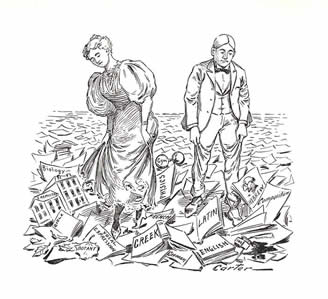Old Oberlin

Scope and Content
Although much has been transferred from Library to Archive control over the decades, an "Old Oberlin" Collection remains with Special Collections consisting of approximately 200 feet of published works by faculty and alumni; approximately 124 feet of unpublished student theses; and 150 feet of “Oberliniana;” books with direct bearing on the local history of Oberlin College, the town of Oberlin, and to a lesser extent Lorain County, Ohio. The collections also contains the newspapers of Oberlin College and Oberlin city.
Image: Hi-O-Hi, 1897 p. 37. Depiction of Oberlin students navigating the many fields of study.
History of the Collection | Historical Context | Additional Resources
History of the Collection
"Old Oberlin" is mostly composed of material from the pre-1928 era, or close to the first 100 years of the College when it was a very different institution. The “Old Oberlin” collection has been in the making since at least 1900 when Librarian Azariah Smith Root sent letters to all living alumni and former students asking for copies of all their publications to form a "permanent" Alumni Collection. Reminders were occasionally inserted in the Alumni Magazine. In his 1907/08 annual report Root further suggested to the Administration that manuscripts and records in College offices be collected in the Library to form the 'Oberlin Archives'. In subsequent reports Root speaks of having appeared before the Village Council to appeal for its records, and of approaching the local churches, the School Board, the Township trustees, and others for records. The library collected all manner of books and ephemera associated with the College and town through the middle of the 20th century; the College Archive having been formed as a separate entity administratively in 1966.
The collection is not dormant; items that fit the first category can sometimes still be discovered in storage or purchased, and many require improvements to their bibliographic records. Local histories are still welcome as relevant new material, and old student theses are sometimes digitized. Almost all of the items in the “Old Oberlin” collection have bibliographic records in the online catalog. It is best searched by author as many of the old records are brief. Ephemeral items that do not have records are being moving to the appropriate faculty and student files in the College Archive.
Historical Context
The term 'Old Oberlin' is borrowed from John Barnard's book From Evangelicalism to Progressivism: At Oberlin College, 1866-1917. In that book, the author dealt with the change in character of the College and notes that it entailed the College passing out of the control of clergymen with a distinctly Calvinist and evangelical Christian mission, and its transition to an ecumenical and secular liberal arts institution. This process of evolution is especially associated with the Progressive Era vision of Henry Churchill King, Oberlin College's President from 1902 to 1927.
King's administration was marked by a change in the identity and direction of Oberlin College that left a mark on much of the later 20th century. Walter Martin Horton, who took over from Henry Churchill King as the Chair of the Graduate School of Theology in 1925, said of King that 'he purged and reconstructed the New School Calvinism he inherited from Finney and Fairchild.' King's much different theology drew instead on the 19th century tradition of German Idealism, the philosopher Rudolph Hermann Lotze, and theologian Albrecht Ritschl. Consequently, King promoted a holistic philosophy of education, and this philosophy has shaped Oberlin College since that time.
Offering further detail, Barnard wrote:
The new progressivism differed from its evangelical ancestor in other respects, since it was not so pervasive as a formative principle of college activities and policies. . . The partial liberalization of college life through the relaxation of social, religious, and intellectual restrictions was a motif in Oberlin's history in this period, although college officials clung to the hope that the restraints of righteous living which no longer could be ensured through regulation might result from choice. Until the disruption of World War I produced powerful pressures for greater personal freedom, they largely succeeded. Much of the zeal that had gone once into the advancement of evangelism was redirected to the pursuit of learning . . . A greater intellectual sophistication and realism modified the idealistic innocence of old Oberlin.
This same transitional time period was emphasized by Geoff Blodgett in his pamphlet Oberlin College: a historical sketch.
Oberlin began in the early 20th Century, during the long presidency of Henry Churchill King, to play the role it has been playing ever since with spectacular success (though the role has always had its critics): that of a pre-professional liberal arts feeder school to the country's leading post-graduate universities. Whereas 19th Century Oberlin graduates typically headed in large numbers into the ministry or school teaching, now increasing numbers of them went on to graduate school to prepare for careers in law, medicine, social work, government service, and--above all--higher education: scholarship and teaching.
Based on assessments like these we have focused the historical collection of “Old Oberlin” authors with the period ending at or before 1927, the last year of King's presidency. 1927 is also the year of Azariah Root's death and represents the latest that items bound for this collection might have passed his examination. It is also worth noting that President Wilkins, inaugurated in 1927, was the first Oberlin College President not from the field of Theology. The transition was by then complete.